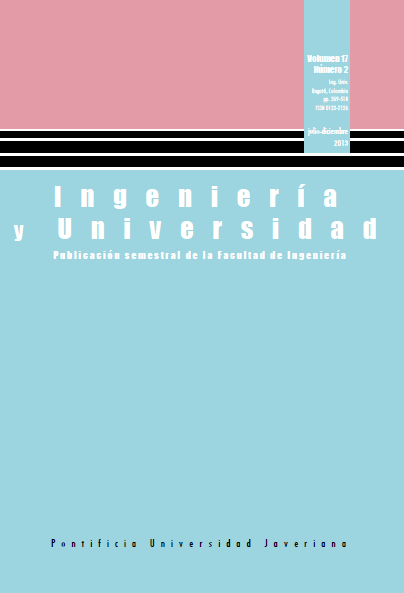Abstract
This article shows the capacity of the Kohonen method in the classification of similar rivers in the light of the determination of regional ecological flows in the Magdalena-Cauca basin, using the methodology of the Ecological Limits of Hydrologic Alteration (ELOHA). For this were used 174 flow stations located throughout the basin, which could be obtained in each case 73 variables for the classification process within ELOHA. Six trials were conducted with different different combinations of variables and the criterion for determining the suitability of each combination to classify the streams of the Magdalena-Cauca basin. When the different combinations were estimated with the Kohonen method, we obtained a similar number of groups to the reference number obtained by Ingfocol in 2010, which was also framed within the guidelines of ELOHA, but using other classification methods different from Kohonen. It was found that the combinations of variables that best were adjusted to the reference classification were the combinations with lower number of variables which were created in order to characterize in summary form the hydrograph of each analyzed flow station.
DE MOYA, M. E. Representación y clasificación de datos geoespaciales: comparación entre mapas autoorganizativos de Kohonen y el método Gas Neuronal. Revista Ingeniería e Investigación. 2003, vol. 53, pp. 12 - 22.
DIEZ, J. M. Memorias del Curso-Taller Modelamiento Ecohidráulico de Caudales Ecológicos. Dictado dentro de la materia Ecohidrología y Ecohidráulica de la Maestría en Hidrosistemas de la Pontificia Universidad Javeriana. 2008.
GAITÁN, C. F. Vigilancia Tecnológica Científica de Ciclos Biogeoquímicos. Journal of Technology Management & Innovation. 2009, vol. 4, no. 2.
INGFOCOL. Informe Final de Consultoría: Implementación de la metodología ELOHA (Límites ecológicos de la alteración hidrológica) para la determinación de caudales ambientales regionales en la cuenca Magdalena-Cauca. Convenio entre The Nature Conservacy (TNC) y el Ministerio de Ambiente, Vivienda y Desarrollo Territorial (MAVDT). 2010.
KENNARD, M. J.; PUSEY, B. J.; OLDEN, J. D., et al. Classification of natural flow regimes in Australia to support environmental flow management. Freshwater Biology. 2010, vol. 55, pp. 171-193.
LIN, G-F. y CHEN, L-H. Identification of homogeneous regions for regional frequency analysis using the self-organizing map. Journal of Hydrology. 2006, vol. 324, pp. 1-9.
MANGIAMELI, P.; CHEN, S. K. y WEST, D. A comparison of SOM neural network and hierarchical clustering methods. European Journal of Operational Research. 1996, vol. 93, pp. 402-417.
POFF, N. L.; RICHTER, B. D.; ARTHINGTON, A. H.; et al. The ecological limits of hydrologic alteration (ELOHA): a new framework for developing regional environmental Flow standards. Freshwater Biology. 2010, vol 55, pp. 147-170.
This journal is registered under a Creative Commons Attribution 4.0 International Public License. Thus, this work may be reproduced, distributed, and publicly shared in digital format, as long as the names of the authors and Pontificia Universidad Javeriana are acknowledged. Others are allowed to quote, adapt, transform, auto-archive, republish, and create based on this material, for any purpose (even commercial ones), provided the authorship is duly acknowledged, a link to the original work is provided, and it is specified if changes have been made. Pontificia Universidad Javeriana does not hold the rights of published works and the authors are solely responsible for the contents of their works; they keep the moral, intellectual, privacy, and publicity rights.
Approving the intervention of the work (review, copy-editing, translation, layout) and the following outreach, are granted through an use license and not through an assignment of rights. This means the journal and Pontificia Universidad Javeriana cannot be held responsible for any ethical malpractice by the authors. As a consequence of the protection granted by the use license, the journal is not required to publish recantations or modify information already published, unless the errata stems from the editorial management process. Publishing contents in this journal does not generate royalties for contributors.


